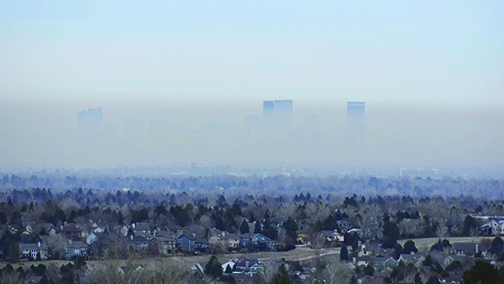
by Regan Bervar | Sep 27, 2021 | Main Articles
“We didn’t start the fire/It was always burning, since the world’s been turning.” Billy Joel
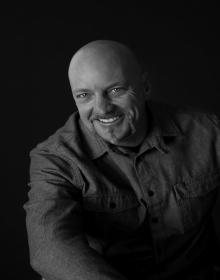 by Luke Schmaltz
by Luke Schmaltz
The brown cloud which frequently blankets the Mile High City has long been recognized as an unfortunate byproduct of progress. Since the 1980s, locally produced carbon emissions from coal-based energy production, oil refinement and the automotive combustion of gasoline has created a problematic airborne miasma. In the last few years, Denver has been given distinction among the top 10 cities with the poorest air quality in the United States. Federal records show air pollution was at elevated levels for more than 260 days a year in 2019 and 2020.
Meanwhile out West, the Golden State is leading the way in the creation of a different type of pollution, wildfire smoke. Just as California exports entertainment, social trends, and hordes of transplants, it also sends a generous share of air particulates from incinerated vegetation to round out its contribution to Colorado. A place that, as anyone who lives here knows, is already dealing with its own wildfire crises.

At times, the brown cloud over Denver can, in part, be attributed to the California wildfires.
Paper Is Made From Wood
To understand the proliferation of pollution, all you have to do is follow the money. America’s addiction to coal-based energy and oil-based propulsion has stakeholders running the ship aground who are perched in plain sight. The same is true with wildfire-based pollution. The logging industrial complex, which is particularly busy in some parts of California, is making a mint while communities are being destroyed, lives are being lost, and Colorado is choking on the ashes.
So far this year, Cal Fire (fire.ca.gov/inci dents) reports 7,377 fire incidents which have killed three people, destroyed 3,285 structures, and burned 2,243,663 acres of forest. The latter statistic is of particular interest here, as the massive plumes of smoke are systematically swept up by jet streams, carried inland, and deposited at the eastern base of the Rocky Mountains.
A Climate-Driven Performance Enhancer
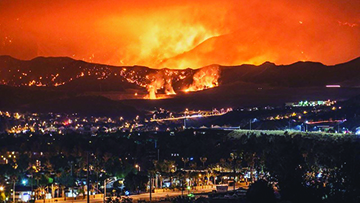
Lucy Walker’s film “Bring Your Own Brigade” tells the story of how concentrated fuel sources are creating fires that can’t be stopped.
Clearly, this phenomenon is ramping up in tandem with global warming. Unnaturally dry conditions can turn large expanses of forest into an incendiary event waiting to turn the tiniest spark into a nightmare inferno. Some of these blazes occur in clear-cut areas which have been recently “thinned” by logging operations both private and government-operated. For decades, the United States Forest Service (USFS) has conducted these “thinning” initiatives under the guise of “fire prevention” but the data overwhelmingly demonstrates that wildfires tend to spread faster and with much more intensity in clear-cut areas due to dry conditions and contiguous acres of branches and logs which were left over from the logging process. Recent examples include the Dixie Fire which incinerated large parts of the Sierra Nevada town of Greenville and the Caldor Fire which destroyed the entire town of Grizzly Flats, CA.
Chad Hanson is an Author and ecologist with the John Muir Project. He recently published Smokescreen: Debunking Wildfire Myths to Save Our Forests and Our Planet.

Author Chad Hanson blows the California wildfire story wide open in his new book, Smokescreen.
Hanson is an expert in the phenomenon and the region, having conducted fieldwork for his doctoral dissertation in the aforementioned Greenville. In a recent article published on Grist.org, he explains, “The primary focus of the agency’s forest management efforts is selling public trees to private logging companies, which generates about $150 million each year. That may sound like a small portion of its $2 billion budget for land management, but logging also brings in more than $1 billion in annual Congressional appropriated funds, which generate additional revenue that goes back into the agency’s budget.” In a clever pivot, the USFS recently stopped using descriptive terms like logging and timber harvest and instead began conducting the same activities under the banners of terms like forest health, ecological restoration, and fuel reduction. But, as Hanson points out, “Make no mistake. It’s all just logging.”
Rural Overpopulation
There is another dimension of the fire industrial complex at work in California, but it stems from an opposing set of dynamics. Commercial land which has been clear cut is being replanted with dense concentrations of trees slated for harvest as soon as they have matured to a certain height and width. The problem here is that thick concentrations of trees, especially those reduced to drought-choked rows of veritable matchsticks, create an overly-abundant fuel source — one which burns with unstoppable ferocity.
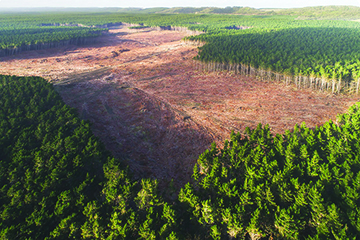
Contrary to popular opinion, clear cutting large sections of forest contributes to the wildfire phenomenon.
Lucy Walker is an Oscar-nominated director whose recent release “Bring Your Own Brigade” is once again heating up the wildfire debate. The film was shot in 2018 during the Thomas Fire in Ventura and Santa Barbara Counties, CA. While the piece makes a strong case for the need to reverse climate change, it also documents how efforts from the USFS and private corporations have created dense forests where a sparse topography once existed — setting the stage for heat- and drought-driven wildfires to thrive. “Comparing photographs makes it very clear,” she explains in the narration. “You can see the changes [through time] and you can see what ‘fire suppression’ has done. Forests just didn’t used to be this thick.” An unnamed resident interviewee confirms this, explaining, “In the past it was more of a savannah situation. Bigger trees spaced farther apart. Now, you’ve created a heat source you can’t stop.”
Professor Pyro
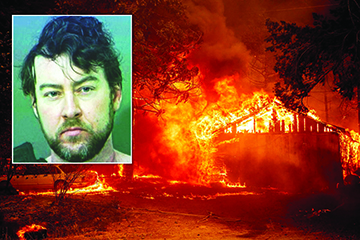
Gary Stephen Maynard, a Criminology professor and holder of a doctorate in Sociology, is accused of lighting forest fires in California.
Gary Maynard is a tenured academic of the California Collegiate system, teaching — quite ironically — criminal justice. The esteemed professor has, until recently, been an enthusiastic contributor to the Golden State’s greatest airborne export. In July and August of 2021, he allegedly went on an unprecedented spree of arson and wholesale destruction. He was recently accused of having set a series of half a dozen fires in the Lassen and Shasta Trinity National Forest areas. These blazes, according to agents from the USFS, were designed to trap authorities and firefighter crews.
Maynard also holds a doctorate in sociology from Stony Brook University in Brookhaven, New York, as well as two additional master’s degrees. Pinpointing his motives will no doubt be a challenge, and reports of court proceedings offer little insight into his mindset — other than repeated denials and blue streaks of profanity aimed at police officers. Whether this is an isolated incident and Maynard is an anomaly, or he is part of a bigger scheme to create anarchy is undetermined. Yet, given the climate of general mania which seems to have much of the general populace in its grip, the idea of a cabal of arsonists creeping about the California woods with a penchant for pyromania is not exactly farfetched.
While California wildfires are certainly not the main culprit of poor air quality in Denver, they are a definite contributor. Hanson and Walker have demonstrated the cause of some of these catastrophes while Maynard has shown how easy they are to ignite. While not wholly unavoidable, wildfires could be reduced were it not for the almighty dollar. This paper byproduct of trees seems to skew the logic of even the most perceptive of people. In this case, it is especially true for those with large government contracts worth many millions of dollars and not a damn to give about who chokes on what, where or when.

by Regan Bervar | Aug 27, 2021 | Editorials
“Courage is grace under pressure.” Ernest Hemmingway
 by Luke Schmaltz
by Luke Schmaltz
Not since the heyday of Gonzo Journalism has a Colorado writer immersed themselves in a story to such a degree, they become temporarily synonymous with the subject of their investigation.
This level of dedication explains why author Julian Rubinstein is laying low. Because for now — he is responsible for introducing oblivious residents of the Mile High City and the world at large to “Invisible Denver.”

Book: The Holly, an epic saga about “Invisible Denver,” is available at julianrubinstein.com.
Rubinstein recently published a book titled The Holly — a factual, multi-generational account of people, events, and places in and around a specific sector of Northeast Denver. This residential and commercial district is home to a variety of small businesses, community centers, a library, post office, the Center for African American Health, and more, Holly Square is also the site of countless gang-related incidents and deadly encounters over the last 30+ years.
A Work In Progress
The area is well known for conflict between Denver gangs and the DPD. Yet, Holly Square also bears the fruits of the efforts of former gangster-turned activist Terrance Roberts and various philanthropists and community outreach groups. On the surface, there is evidence of an influx of big money bolstering new development such as the Nancy P. Anschutz Center/Boys & Girls Club which opened in 2013. This has a seemingly synergistic effect on long-established neighborhood institutions, namely the shops and businesses in the Park Hill Center. On a deeper level, however, linger the ghosts of a community long-affected by civic dysfunction and gang warfare.
The Promised Land
Beginning in the 1950s, Rubinstein reports, this area was the Plymouth Rock of a migrating African American populace fleeing the Jim Crow South in search of a better life. Among them was Terrence Roberts’ grandmother, Ernestine Boyd, who was soon followed by most of her immediate family — whom she managed to move to Denver one by one from an Arkansas cotton plantation. “Most people don’t associate Denver with having much of an African American population or culture,” Rubinstein begins. “But of course, there is a very strong one that begins very early,” he explains. The Holly is the de facto epicenter of what Rubinstein’s book reveals as “Invisible Denver” a subculture extending across multiple neighborhoods that most folks beyond the zip codes therein are unaware of.
The Story That Hit Home
The germ for The Holly was planted in 2013, when a national news piece caught Rubinstein’s attention (a Denver native) while he was living in New York City. It involved former Bloods gang member-turned anti-gang activist Terrance Roberts, who was involved in a shooting incident in Holly Square that nearly claimed the life of then-active Bloods gang member Hasan Jones.
Over the next seven years, Rubinstein would immerse himself in the subculture of The Holly. “I didn’t know what I was going to find, and I didn’t expect to find what I did,” he explains. “It ended up feeling like a responsibility that I didn’t always want.” The book is an opus driven by equal amounts journalistic curiosity, humanist compassion, and nerves of pure steel. He documents in great detail how he was able to gradually befriend Roberts, Roberts’ father George (a funeral preacher), and an extended network of characters who don’t normally associate with Caucasian journalists.
Dysfunction Junction
Perhaps the most disturbing set of circumstances Rubinstein uncovers are those demonstrating the monumental failure of Denver law enforcement to address and reverse the ongoing crisis of gang violence. His reporting reveals that active gang members were recruited by city-appointed officials and placed on payroll to perform “outreach” to the community’s at-risk youth. “For much of the time I felt like I was doing government oversight work,” Rubinstein explains. Rubinstein refers to this as the “urban war industrial complex,” and he demonstrates that as certain government-sponsored “anti-gang” programs were implemented, the violence only increased.
Internal Perspectives, Conflicting Opinions

Author: Julian Rubinstein is a Denver native who was compelled to return home and uncover the truth about “Invisible Denver.”
Rubinstein’s story presents a comprehensive, multi-generational account of local African American history, gang culture, activism, anti-activism, and urban development. Folks who want to get to know “Invisible Denver” can start by reading The Holly.
Like many journalists, Rubinstein is not without detractors. One such figure is Jeff S. Fard — founder of Brother Jeff’s Cultural Center, and a well-known figure in the Northeast Denver community. He is a lecturer, multimedia journalist, and community organizer. He is also a regular guest on a local radio show hosted by longtime Denver on-air personality Peter Boyles.
Brother Jeff’s outspoken criticism of Rubinstein on Boyles’ 710 AM KNUS radio show has brought more than a few questions to the fore. When asked about his ire toward Rubinstein’s reporting in The Holly, he replied with a litany of misreported facts such as incorrect ages, school attendance statuses, and gang affiliations, and more. Brother Jeff attests, “ If these basic facts are not correct, how much can larger facts be trusted?”
Infractions, Minor And Otherwise
Rubinstein has taken note of these oversights, and vows to correct them in future editions. “Well, thankfully these are minor infractions,” he explains.
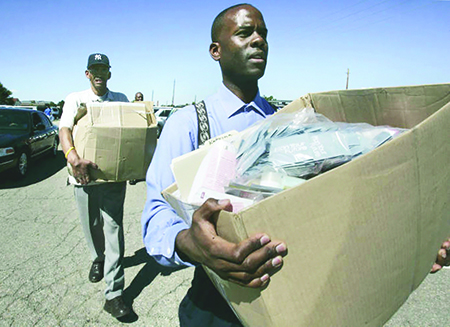
Brother Jeff: While Brother Jeff credits Rubinstein with making some good points, he has far more critical bones to pick with The Holly.
Brother Jeff has bigger fish to fry. “Initially, I thought The Holly was a product of journalism and reporting,” he states. “It only took me a few pages … to realize the book is more of Terrance Roberts’ story as told to Julian Rubinstein. I have many questions for Julian. For example, does Roberts receive any royalty payments from the book? Was he paid? If so, that departs from any journalistic effort I am familiar with. I have been around Roberts long enough to hear his voice and tone in much of The Holly.
Brother Jeff continues his invective, “Flames burned down The Holly, and now, the opening of unresolved issues and wounds are tearing the community apart again. In fact, after 400 pages most walk about asking, what is that book all about?”
One of Rubinstein’s main revelations in The Holly is evidence of police corruption. Specifically, in the claims that active gang members are recruited by DPD and other official agencies to, ironically, work in the capacity of anti-gang outreach for at-risk youth. Rubinstein cites numerous sources and instances to support this claim, yet Brother Jeff has a different story to tell concerning this issue.
An Ongoing Debate
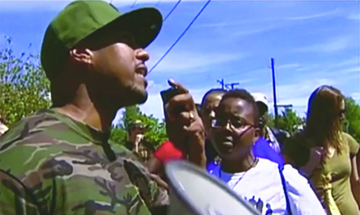
Focus: Terrance Roberts, seen here rallying for the community, is the primary focus of The Holly.
When asked about police corruption, as reported in The Holly, Brother Jeff states, “Initially, community and city collaborations regarding youth were done through a program known as Safe City. Mayor Webb placed this within the Manager of Safety office. That office is more than the police. It is Sheriff, fire, and even the Independent Monitor. Later GRID and Safe City kinda merged and Safe City became Safety Programs. This work is also under the Manager of Safety. I don’t know too much about police recruiting anyone from community based programs,” he explains. “They may have recruited confidential informants etc…, but no one I know would know anything about that.”
Meanwhile, Rubinstein denies having a partnership with Roberts, and is quick to defend his revelations about misappropriation of government funds for anti-gang, community outreach. “Because Brother Jeff didn’t hear of any DOJ funding doesn’t mean it wasn’t there,” he explains.
As with most polarized issues, the complaints are many and the grudges run deep — indicating the disputes arising from The Holly will smolder on. Which, alas, may help make Invisible Denver not so invisible.
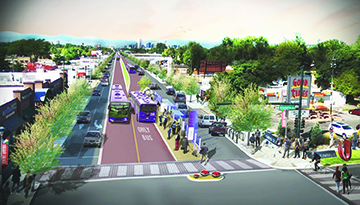
by Regan Bervar | Aug 27, 2021 | Main Articles
“It seems as though all the devils were let loose on me; and if you think this is an exaggeration, ask anyone you meet who has lived in my district.”
 by Luke Schmaltz
by Luke Schmaltz
Colfax Avenue is revered, reviled and renowned — a pulsating conduit of commerce, crime and culture. If you live in Denver, you have inevitably been swept into its current, and the experience has no doubt left an indelible impression.

East Colfax: An artist’s rendition of what East Colfax might look like once the project is complete. This rendering is the intersection of Colfax and Krameria.
At any given moment along America’s longest avenue, nearly every type of human being on the move can be observed; pedestrians, drivers, motorcyclists, public transit customers, bicyclists, scooterists, skateboarders, and folks of questionable mental alertness doing their best to stay upright as they stagger along their way. According to a recent post on the RTD-Denver .com website, approximately 20,000 people travel this route every day going to and from work, play, and myriad other destinations. Related metrics posted on denver gov.org state, “Over the next 20 years, the corridor is expected to experience 25% growth in the number of travelers, 67% growth in employment and 25% growth in population. Denver cannot continue to grow and create more people-friendly spaces without efficiently moving more people through the East Colfax corridor.”
Current Projections
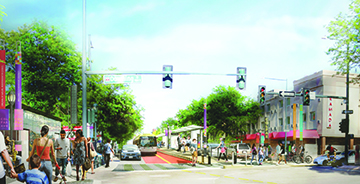
Colfax And Downing: The Colfax BRT would run from Broadway to Yosemite St. in Aurora.
It is apparent that, with the current rate of growth in the Mile High City, the need to access this route will far outweigh the volume per hour capacity and thus, the Colfax Corridor BRT (Bus Rapid Transit) Project was initiated by the City and County of Denver. According to a quote on the Streets blog.org website from Jill Locantore (of the Denver Streets Project) this initiative, “is going to allow Colfax to carry more people than it does today. If you get more people out of their cars and on the buses, you have nearly infinite capacity for people, compared to very limited capacity for personal vehicles.”
Benefits vs. Drawbacks
The project proposes the replacement of side-running BRT with two repurposed center lanes for transit-only vehicles which passengers will access via elevated, wheelchair accessible platforms. Among the advantages listed on a denvergov.org web page are better-organized traffic flow, reduced crashes, improved travel efficiency, reduced conflicts with parking and other related curbside activities as well as streetscaping opportunities. Another listed benefit will be “improving pedestrian safety by moving transit lanes to the center.” This is where some highly questionable oversight may be at work, as the idea of people disembarking from public transit in the middle of Colfax and presumably making their way from the center to one side of the street elicits images of pedestrians being mangled by oncoming traffic a-la the 1980s video game Frogger. Sure, travelers will no doubt be instructed to use the crosswalk, but those who exit the BRT shuttle toward the rear of the vehicle — at the furthest point from the crosswalk — will inevitably take a shortcut to the sidewalk and simply jaywalk across the street. It is Colfax Avenue, after all — not exactly a place where people go to follow the rules. Add the winter conditions present in Denver half the year, the pedestrian danger could elevate to Ice Road Trucker Frogger.
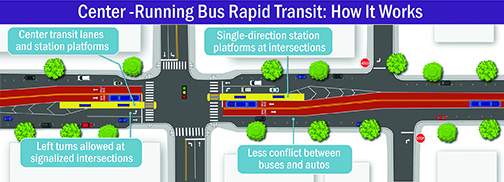
BRT: The East Colfax Corridor Bus Rapid Transit (BRT) Project is still in the planning stages and may not see completion until 2028. Image: Denvergov.org
While popular among developers and city agency personnel, BRT presents a host of pressing concerns among residents and local business owners. The driving lanes will be reduced to just one lane for motor vehicles traveling east and west from Broadway in downtown Denver all the way to Yosemite St. in Aurora. Artist renditions of the proposed configuration present the very picture of congestion — a condition that could spell certain doom for streetside businesses.
Insight From A Bureaucracy Outsider

Velvet Elvis: Colfax Museum curator Jonny Barber (aka Velvet Elvis) has some transit enhancement ideas that are a bit more eccentric than those of the Colfax BRT.
Jonny Barber is a celebrated Denver musician, highly sought-after Elvis impersonator (The Velvet Elvis), curator of the Colfax Museum and administrator of the popular website ColfaxAvenue.org (along with wife Anistacia). Barber is considered by many to be the preeminent local authority of all things Colfax Avenue, including past iterations as a well-managed thoroughfare. He recalls how from the late 1800s until around 1950 or so, much of the traffic on Colfax was managed by streetcar trolleys which shuttled residents from west to east and back again. He contends that the original tracks still exist beneath a few layers of asphalt, and that perhaps a step back in time is a better approach. “Yes, we need transit on Colfax,” he begins. “Is BRT the answer? I don’t know but while we’re at it — we might as well do something a little sexier — like bring back the trolleys.”
A Crowded Kitchen
Meanwhile, BRT planners postulate the project will not reach completion until 2028, with a host of bureaucratic agencies acting as stakeholders, the process will no doubt be hindered by a quagmire of negotiations, objections, and red tape of every stripe. To elaborate on the complexity of the various agencies at play, CDOT (Colorado Department of Transportation) owns the actual road that is Colfax Avenue, RTD operates the public transportation vehicles, the City of Denver DOTI (Department of Transportation and Infrastructure) is responsible for maintenance and operation, and the FTA (Federal Transit Authority) is overseeing the entire BRT project. All parties must agree on how things will be managed, paid for, contracted, and carried out. Such a complex proposition is not just a traffic jam, but a multi-vehicle pileup that works well as a fitting metaphor for the future of Colfax Avenue.
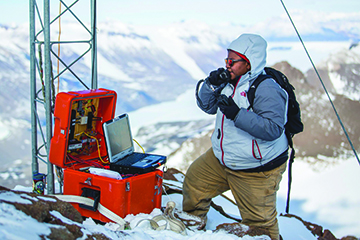
by Regan Bervar | Jul 23, 2021 | General Featured
“Antarctica has this mythic weight. It resides in the unconscious of so many people, and it makes this huge impact, just like outer space. It’s like going to the moon.” Jon Krakauer
 by Luke Schmaltz
by Luke Schmaltz
Currently, there is a palpable mood of distaste among Denver’s working-class citizens. Jaw-dropping rent rates, lack of jobs offering a sustainable wage, mounting inflation and rising crime have a lot of people looking for a way out.
If these circumstances resonate, perhaps you have fantasized while stuck in bumper-to-bumper traffic and wondered to yourself, “What if there was somewhere I could go where I could work at my chosen profession and be properly compensated while not having to commute, pay rent or spend money on food or clothing?” If you think this sounds too good to be true, think again. The portal to this magical land of vocational and existential idealism is located right in your own backyard. It’s the Leidos Antarctic Support Contract (ASC) office — just south of Denver in Centennial, Colorado.
Step Right Up
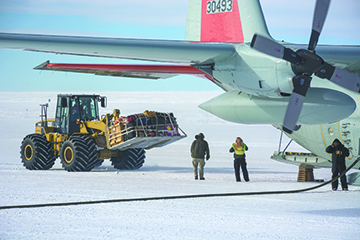
A loader brings a pallet of luggage to a recently-landed LC-130 that’s also preparing to depart from the Amundsen-Scott South Pole Station. Planes can only stay on the ground for a short period of time at the pole, on account of the extreme cold.
The communications agent at the ASC, Elaine Hood, explains, “Interested people should visit www.Leidos.com/Antarctica to learn about the Antarctic Support Contract. That page lists the various companies that hire for different jobs in Antarctica.” Website visitors will find an amalgam of overlapping agencies with similar jurisdictions and functions. The Centennial recruiting headquarters is, in fact, an umbrella organization involving an extensive network of subcontractors. These include GHG Corporation, Gana-A’Yoo Services Corporation (GSC), PAE (Pacific Architects and Engineers) and University of Texas Medical Branch (UTMB). Each agency maintains a presence in the Centennial Leidos office while using a variety of extraneous recruiting resources such as SEO-enhanced websites and independent HR campaigns. Many recruiting sites are domains named after popular search terms such as www.cool antarctica.com and www.wandereatwrite .com.
Vocational Abundance
Currently, there are listings for dozens of available IT positions including network engineers, computer technicians, broadcast engineers and web applications developers as well as a few hands-on positions such as antennae rigger and mammal observer. The medical contingency is also hiring for positions such as physicians, mid-level practitioners, dentists, nurse administrators and physical therapists — to name a few. The trades are also hiring with listings for shop foreman, fleet operations foreman, plumber foreman, preventative maintenance foreman, cook, electrician, carpenter, firefighter, boat handler, diving officer, radio operator and many more.
Elaine Hood places emphasis on the fact that Antarctica, for obvious reasons, is in fact experiencing a labor shortage. “The more skilled trades positions are difficult to fill simply because they require certifications and years of experience doing specific jobs such as being a refrigeration mechanic. Yes, we need freezers in Antarctica to preserve frozen food as well as science samples! Positions can also be difficult to fill because people must leave behind their family and friends for six months, over holidays, birthdays, anniversaries, and other milestones that occur between October and March.”
The Upside Down
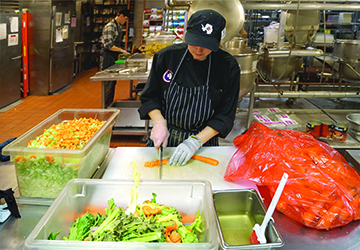
Food being prepared at McMurdo Station, Antarctica, for the Thanksgiving holiday meal. Fresh vegetables, known as “freshies,” are greatly desired where they are scarce. Photo credit: Mike Lucibella, NSF
Currently, a hiring campaign is underway for the upcoming summer season. In Antarctica, this season goes from October through February while winter goes from February until October. The summer is the easier of the two, featuring average daily temperatures of around zero degrees Fahrenheit while a “winter over” as it is locally known, can feature a consistent deep freeze chill of 30 to 40 degrees below zero. “Everything is more difficult in Antarctica,” Hood explains, “and takes longer than it would off the continent. That can be frustrating. While we try to have spare parts in warehouses, occasionally something may break on, say, a snowplow that will require that part to be flown in. That one part can take weeks to reach Antarctica.”
Hood continues, “Some positions receive few applications and are difficult to fill, while others receive thousands of applications and are easy to fill. For example, finding experienced tradespeople — diesel mechanics, plumbers, electricians — can be difficult. We need people who can troubleshoot and resolve problems based on years of experience. People with that level of expertise may not be in a personal situation where they are willing to be away from family for six months over the holidays (Sept.-March), so we don’t receive as many applications for those positions as we would like. On the other hand, working as a steward in the cafeteria is a position that hundreds of people may apply for.”
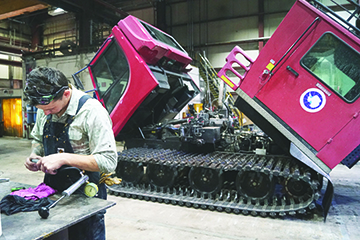
Light Vehicle Technician Matt Means works on a PistenBully inside McMurdo Station’s Vehicle Maintenance Facility. Mechanics are a critical position in support of scientific research in Antarctica. Photo credit: Elain Hood, NSF
Unexpected Discoveries
If you land a job, you might end up staying longer than you planned. “In general, we have about 60% return [of seasonal workers],” Hood begins. “We have many people who will take an entry level position just for the opportunity to be paid to work in Antarctica. Let’s say they are a high school teacher who thinks she is taking a one-year break from teaching. She may work as a steward in McMurdo Station, replenishing food on the cafeteria buffet line, but as the season progresses, she realizes she has met the most extraordinary people and applies to return for a second season in the Supply department. The research stations have supply warehouses where everything from plumbing, food, electrical and other inventory are kept — remember there are no supermarkets and Home Depots in Antarctica. So, she applies for and returns for her second season in the Supply department and the next thing you know she has been deploying for a dozen years when her original plan was to only go one time. We have people who have been doing this for 10-20 years.”
An Adventure Awaits

McMurdo Station Communications Supervisor Teri Cotton tests a radio installation from atop a mountain in the Transantarctic Mountains. Antenna riggers and radio repair and maintenance are two of hundreds of jobs required to support the U.S. Antarctic Program. Radio repeaters are installed to facilitate communication in the region of McMurdo Station. Photo credit: Johnny Chiang, NSF
Should you get hired as a U.S. citizen, your likely landing place will be McMurdo Station — the logistics headquarters of the United States Antarctic Program and the largest of three research stations run by the National Science Foundation. The other two are Amundsen-Scott South Pole Station and Palmer Station. At McMurdo, which is more like a small town than a research station, you will live and work among 1,000 or so other residents for the duration of your contract.
Elaine Hood breaks down what to expect, “Once a contract is offered, the candidate must complete a medical and dental examination to be deemed physically qualified (PQ’d). Each of the three USAP stations has a medical clinic and a doctor, but there is no dentist. The medical clinics are not equipped to handle long-term care for major health crises such as strokes or heart attacks. The objective of the PQ is to screen out applicants whose health may be at risk of a major incident.
Once you have been PQ’d, you get advice on what to pack for your particular job, such as work boots and long underwear. You will be flown to either Christchurch, NZ, or Punta Arenas, Chile, where you will receive cold-weather clothing — heavy parka, gloves, wind pants — that will be returned to inventory upon your departure from Antarctica. During this time, you will attend training and orientations so that when you arrive in Antarctica you are ready to begin working.”
A Living Wage
If you’re thinking about taking the plunge, consider that with no extraneous spending temptations or basic living expenses, you might be able to save a fairly sizable chunk of change. Then, when you return to Denver, perhaps you can afford a down payment on an insanely overpriced house. Or you can sign another work contract and turn around and go back to Antarctica, hoping perhaps on your next return things in your beloved Mile High City have improved.

by Regan Bervar | Jul 23, 2021 | Glendale City News
 by Luke Schmaltz
by Luke Schmaltz
Thus far in 2021, active shooter events have occurred over 150 times in the United States. People are going about their business — be it school, work or play — and in an ear-splitting instant, life turns from normalcy to chaos, confusion, and potential death. This is when the instinct to survive kicks in, and you have three options: Run, Hide, Fight (RHF).
However unfortunate, this patently American phenomenon could occur at any point. It is important for survival to understand the RHF protocol and why it presents an actionable methodology for dealing with danger.
Run For Your Life
When the shots ring out, the shock of gunfire could make you freeze — as panic temporarily seizes your ability to move. You must overcome crippling fear

Glendale Police Department offers sound advice for responding to an active shooter situation.
and use your ambulatory efficiency to create as much space as possible between you and the shooter. If you are outdoors, you have the advantage of square footage, and you are wise to get as far away as possible as quickly as you can. As you flee, even if you assume others have called 911, call anyway. Your coordinates and your perception of the events could give police responders crucial intel for handling the situation. Captain Michael Gross of the Glendale Police Department offers a bit of sound advice, “Don’t run blindly, pick a direction based on good knowledge, and encourage others to run with you.”
Hide Smart
If you are indoors during an active shooter event and you run, seek to escape the confines of the building immediately. If exit is not an option, you must use the building itself and its internal structure as defense. A room with a door which can be locked is an excellent option, turn off all lights and be as silent as possible. Close all blinds and, as you call 911, speak quietly and be sure to silence your phone — as a ring-back or text notification could alert the shooter to your whereabouts. Brick walls are preferable, as they can be impenetrable by some bullets, but the main idea is to put as much physical matter between you and the shooter. Stairwells, while seemingly protective, can also be a trap if you are in a high rise building and there are multiple shooters. Captain Gross offers actionable advice for this situation. “We have never had an active shooter breach a locked door.” He explains. “Getting behind a locked door is your best chance for survival. But don’t lock yourself in, someplace easy to get into and out of is best.”
Fight Like Hell

The RHF Protocol can save your life in the event of an active shooter.
If your hiding place is discovered, you may be in a position where fighting is your only option for survival. Your 911 call, while received, will take crucial minutes (anywhere from seven to 10) to be acted upon by the local law enforcement authorities. You must fight back with whatever tools are at your disposal. Captain Gross reinforces the notion of using the resources at hand to fight back, “Anything can be used,” he begins. “One of my personal favorites is the fire extinguisher. They are present in all buildings per the fire code, they make it difficult to see, difficult to breathe and really hurt when you get hit with one.”
Inside Reasons
Captain Gross also offers key insight into the backgrounds of many active shooters. “Active shooters are not trained; they have very little skill; the average person can succeed against them easily. Because they have no or little training they are not prepared for resistance. Dr. John Nicoletti [an expert in workplace and school violence based in Lakewood, Colorado] calls this the ‘thrill of the thought.’ When they plan out their act, they don’t plan for resistance, so they don’t know what to do when it comes. This is also one of the reasons why active shooters commit suicide in such high numbers.”
Captain Gross also presents important insight into the motivations of many active shooters, citing workplace discord as a catalyst. “70%-ish of active shooters come from inside the business (employees or recently fired).” He explains. “They exhibit behavior over time that, if you are sensitive to it, telegraphs their intentions and gives opportunity for intervention. 82% or so broadcast their intentions to others (usually through social media). Of the roughly 30% left, the vast majority of those are domestic violence attackers. Active shooters plan their assaults. They make these plans for very different reasons.”

Fire extinguishers are common throughout public buildings and can be used to distract or disable an assailant.
If you find yourself in the confines of an area which you cannot escape, attempting to reason with an active shooter will only give them a greater focus on your whereabouts. Also, whilst under duress, talking will only drain your energy from the mission at hand which is to subdue the shooter by any means possible. Any martial arts training you may have could serve you well here — as in most disciplines, self-defense is the directive.
Addendum To The Protocol
Since the RHF protocol was established in 2012, a fourth element is becoming an apparent addition to the mindset — hemorrhage control. This is the idea that every citizen — while understanding running, hiding and fighting — should also have fundamental knowledge on how to stop bleeding caused by a gunshot wound. This applies not only to yourself, but to those around you. Applying a tourniquet to a limb or direct pressure to a wound can buy a victim precious minutes while help arrives. Captain Gross explains, “Have an active shooter plan for your business, get training (both in active shooter response and basic hemorrhage control). Give good information, description and whereabouts. When police arrive, have NOTHING in your hand, don’t grab the officer, don’t pull the fire alarm.”
Hemorrhage Control
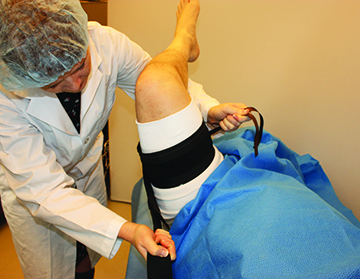
Knowing how to improvise and apply a tourniquet is a crucial part of hemorrhage control.
Injuries to the head or torso require direct pressure with some sort of dense, absorptive material. In the event of a wound to an arm or a leg, a tourniquet can be used to control the bleeding. In an active shooter scenario, you will have to improvise with whatever materials you have immediate access to. Begin by pinpointing the exact location of the wound and exposing the skin. Inform the victim that you will be applying a tourniquet, as their already severe level of pain will be temporarily increased. It is important that the tourniquet be applied between the extremity wound and the heart. The American Red Cross recommends placing the tourniquet two inches above the wound. Use a cloth, towel, scarf or strip of clothing to wrap around the limb and tie it with a regular square not. Then, you will need to apply what is known as a windlass, which is a stick or a ruler — anything strong enough to be used to twist the tourniquet tighter. Place the windlass on the square knot and use the loose ends of the tourniquet to secure it with another square knot. Then, twist the windlass to tighten the tourniquet until the bleeding stops. Once the bleeding has stopped, use another strip of material to tie the windlass to the victim’s limb so that it stays tight. First responders will take over once they arrive, yet be advised that no tourniquet should be left in place for more than two hours.
Regardless of whether you run, hide or fight — the life you save could be your own at the very least. In a best-case scenario, you could help those around you, and if they have the same mindset, perhaps they can help you.






















